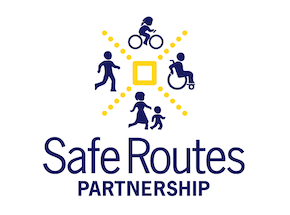Resource Library
This report presents the results, lessons learned and recommendations identified during the Project’s 20-month period. The Project involved a review of the relevant literature, development of a logic model, design and implementation of data collection tools, analysis of findings, and establishment of conclusions and recommendations.
The Safe Routes Partnership has developed an Educator's Guide for getting students active through Safe Routes to School.
This 2-page document describes the main national organizations and entities supporting and advancing Safe Routes to School - Federal Highway Administration, state departments of transportation, National Center for Safe Routes to School and Safe Routes Partnership.
The Safe Routes Partnership's 2011-2015 final Strategic Plan was adopted by our Steering Committee on November 3, 2010. A sincere thank you goes out to the nearly 1,000 people who were interviewed, completed a survey, attended our annual meeting and/or provided written comments on the draft strategic plan.
Executive Summary for the Safe Routes Partnership's 2011-2015 Strategic Plan.
In 2010 and 2011, the 20 state networks engaged more than 600 partner organizations and agencies in policy priorities based upon the following policy categories:
The Safe Routes Partnership has developed a Low-Income Guide for assisting volunteers and professionals with implementing Safe Routes to School in low-income schools and communities.
This report describes the strategies, partners, successes and lessons learned from the Safe Routes to School state network project in 20 states during 2010.
School facilities and grounds are integral components of public infrastructure that provide students with space to learn, socialize, and exercise.
To assess existing research on the effects of various interventions on levels of bicycling. Interventions include infrastructure (e.g., bike lanes and parking), integration with public transport, education and marketing programs, bicycle access programs, and legal issues.
School districts, local municipalities, and/or nonprofit partners throughout the country are countering the common separation of uses and working together to accommodate school and community needs on school property.
Trust in an examination of community schools from a rural perspective.
This study examines changes in state-specific obesity and overweight prevalence among US children and adolescents between 2003 and 2007 through a cross-sectional analysis of National Survey of Children’s Health data.
Understanding the potential relationship between the built environment and active school transportation (e.g., walking) empirically is essential to the development of effective planning interventions.
Recent research suggests that racial residential segregation may be detrimental to health. This study investigates the influence of neighborhood racial isolation on obesity and considers the role of neighborhood disorder as a mediator in this relationship.
This study examined the association between the level of physical activity (PA) friendliness of the built environment and adolescent PA and body mass index using a national sample of youth and data collected from the communities where they reside.
This review assesses existing research on the effects of various interventions on levels of bicycling including infrastructure, integration with public transport, education and marketing program, bicycle access programs and legal issues.
This study examines the association between the level of physical activity (PA), friendliness of the built environment and adolescent physical activity and body mass index using a national sample of youth and data collected from the communities where they reside.
Walking to and from school contributes to total physical activity levels. This study investigated whether perceived and actual neighborhood features were associated with walking to or from school among adolescent girls.
In this study, McDonald traces the evolution of school siting standards, explains the factors currently influencing school facility location decisions, and identifies what local and regional planners could contribute to school siting decisions.

